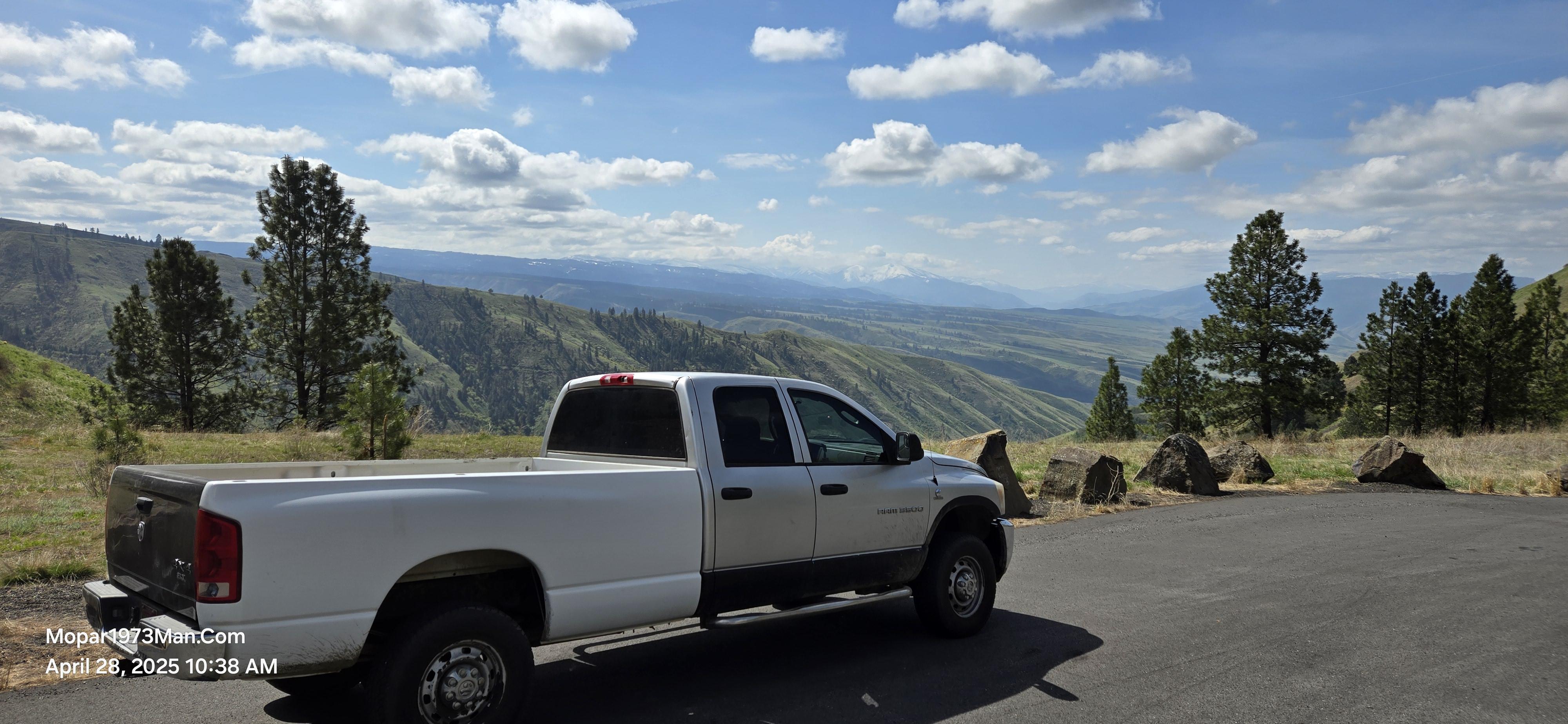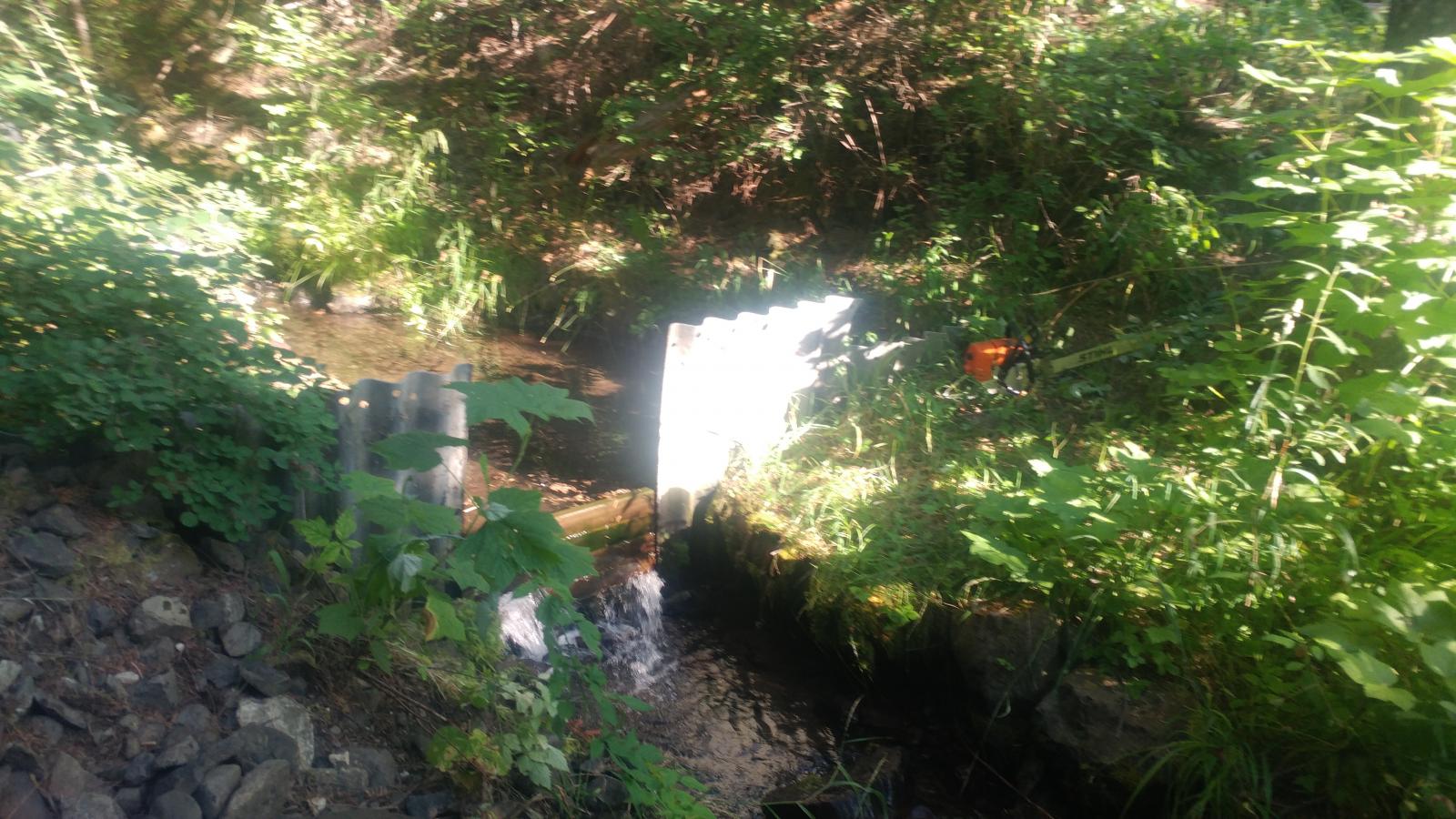
Everything posted by Mopar1973Man
-
Thermostat... just a good one
I've been using NAPA thermostats no issues.
-
Help with a Towing Tune
Yeah I just figured out the oil temp trick. When timing is too advanced you'll heat soak the coolant jack at the cylinder area this makes it hard to dump oil heat into a hot coolant jacket. The way to verify this is engine load will be lower this is good because less fuel in needed to keep rolling. Then EGTs are lower and coolant temps too.
-
fuel pressure gauge
Just installed a set of ISSPro EV2 in @mr.obvious truck on Tuesday. I've got to program his gauges in one of my next trips. Right close to $500 for everything. Plumbing pieces, tubing, bracket and fittings, etc. I'll grab photos next time.
-
Help with a Towing Tune
I think you need to drop -1 from the max timing across the board. This will build boost much easier for towing and get you launched better. Monitor your engine oil temp with the transmission probe. When your timing is too high the oil temp will rise above coolant temp. You should be -10 below coolant to just equal to coolant temp.
-
Front breaks hot.
If you do might buy a seal kit for each of them about $4 a piece. Done it many of times on my own truck.
-
Front breaks hot.
Typically binding calipers is from debris in the piston area binding up the pistons. Typically people bleed the brakes and it pushing the trash from the master cylinder into the calipers and settles to the bottom now after a small amount of time the piston sliding back and forth it will eventually bind up.
-
Radiator flush
Biggest thing everyone check for freeze point of the coolant but I rarely ever see anyone test for pH level of the coolant. Like the local shop does a freeze point check but they end up changing water pumps all the time. Even though I keep telling to check the pH level they never do. They just continue to change water pumps. Radiator plugging up for most of them. I just shake my head...
-
Cellphone service at home
So far this new 4G Samsung unit is working awesome. I just had a client show up to make a parts payment for dual disk clutch and tuner. Just in the mere 15 minutes he was here his phone rang twice which blew him away. Wonder how could he get cell service way out here. I showed him the unit and he's been considering buying one as well for his home business. So far since I set up both units on a table and in the window both WiFi and 4G cell service spans the yard nicely now. Frontier DSL internet on the left and the Samsung / Verizon Network Extender on the right.
-
Radiator flush
Actually the mineral content of the water had nothing to do with it. Being I've had my well water test numerous times. It's actually the pH of the water that is the most important. Both my water sources are carry mineral and metals but the pH of my water is near a perfect 7.0 on the scale. My irrigation water is from a creek with mineral and metals dissolved in the water as well but again the pH of the water is still close to neutral. Its the city water where chlorine and fluoride is added to the water and becomes too acidic typically (too low in pH scale). This wipes out the pH additive of the coolant and now the coolant is still too corrosive and the water now start dissolving metals into solution. This is what makes the scale build up in the radiator as the water cools the oxides come out of solution and deposit in the radiator typically. This is why its still possible to have scale build up with distilled water is because with time the coolant will gain a charge and typically start leaning acidic sided because of the huge current flow during cold starts in the winter time. This can be seen with a DVM dipping the RED probe in the coolant and the black probe to battery ground. More corrosive the more of voltage charge the coolant will have. Here is my 1996 Dodge with distilled water and coolant and it still ate the thermostat housing neck and distilled water did not save this!
-
Passenger side battery tray removal
Fender well look up under the fender skirt there should be 2 more bolts.
-
AC ripple Testing
Depends. Full load ripple is going to be much higher typically the local NAPA passright right around 1.0 volts AC at full load 136 Amps. Idling engine and no load with DVM you want to be 50mV AC or less. Output voltage is meaningless. It the ripple voltage that is critical here.
-
Radiator flush
Never touched distilled water. Either used well water or creek water. Closing in on 400k miles and still have ZERO scale build up in 17 years and 390k miles. Open the drain, pull the thermostat and chuck it in the trash. Flush the block with lots and lots of water with the engine idling. With the thermostat out the water will flow rather easy and fast even at idle. Once the engine is flushed out allow all water to drain. First gallon of coolant I put in 100%. All following coolant will be mixed 50/50. Fill till the coolant is just about to spill out of the thermostat hole. Install a NEW NAPA thermostat 190°F thermostat. Then top off with coolant. Go for drive watch for the thermostat to open. Come back and check your coolant level. Be careful the coolant and engine is now hot. Never touched distilled water... 17 years, 390k miles, no scale build up or failures as of yet. Still have my OEM water pump and radiator. This is how much coolant is left with just the drain cock on the radiator. Next to nothing. If you want more out just park nose down. My water source, my irrigation dam 1/3 of a mile behind the house. Just about due for a coolant change too.
-
Qaudzilla iqaud tunes
My economy tune doesn't require wire tap. I typically use level 2 or 3 for daily driving to limit fuel tables as needed. 4 and above just added fuel and degrades the MPG numbers.
-
Dreaded White smoke.
When the head was done was the valve guides all replaced? If not the valve seals will not hold up. The valve will move and rock and tear up the valve seals. Typically if you in the smoke it will smell like burning engine oil. Do you have any P0216 code? Bad injection pump with a stuck or seized timing piston will create some weird issues. How old are the injectors (mileage)? It's possible the pop pressure is too low and the idle spray pattern is pissy and creating the blue smoke from poor pop pressure. This will have the smell of raw fuel and typically burns the eyes.
-
Qaudzilla iqaud tunes
Then the download area... https://mopar1973man.com/files/category/22-quadzilla-standard-tunes/
-
Cellphone service at home
Network extenders are really common down here. There is at least 4 or 5 places I know that have the extenders and work rather well. I can stop out if front of the these homes along the highway and place phone calls. My mistake was I bought a refurbished unit that had issues still. Verizon Tech Support sent the new unit 4G Samsung to replace the old obsolete unit. Verizon informed me that 3G unit will be pulled from service very soon like the end of the year. I would had to upgrade anyways. The 3G Samsung worked really good providing signal across my entire yard. Worked really well. Just for some reason the unit would kick out and re-start training for internet signal and GPS signal all over. Taking up to 2 hours to come back on line. The new 4G unit came with a GPS extension cord so I could get the GPS head to the east side of the building and now have at least 6 GPS satellites. Just in the time to type this the unit is setup and complete. 4G signal and functional.
-
Faulty Cruise Control
PCM fault, Central Timer fault, wiring issues, etc.
-
Bucking at low RPM's
In a nutshell. "Max Timing" sets the maximum limit of advancement, excluding cruise timing which stacks on top of this. Now the rest of the setting like load based timing and low psi timing reduct are all amounts of retarding from the Max Timing number. The other clue is oil temperature oil should be roughly -10°F cooler than coolant temperature. If oil temperature is above coolant your too advanced and burning too much fuel on the cylinder wall and not in the bowl of the piston. If the oil temperature is colder than -10°F then you most likely retarded too deeply burn most of the fuel on the downward stoke and blowing most of the fire out the exhaust. This is not exact science but a good way to find timing range.
-
Tie rod ends
My OEM tie rod ends lasted till 350k miles. Replaced with greasable NAPA and so far still doing great. Steering is still tight and still straight. Almost to 390k miles. Still running 1,000 miles a week. I know there is no reason to chase the upgrade ends (T vs Y steering) nor attempt to chase down the OEM original that lasted 350k miles being its no longer manufactured and I've got no lift or leveling kits so the geometry of my front axles is still correct. I'm running 30 inch tires (254/75 R16) and it reduces the stress on the joints just a bit.
-
Tie rod ends
Moog is no longer USA made. The company was bought out and moved over seas.
-
Detailing stuff waxes, plastic preservatives, etc
As for the plastics I've been using... Armor-All. Most people use it wrong. I spray it on in the heat of the day with the door open and allow it to bake to clear state on the plastic. DO NOT wipe off. Just spray on and wall away. I'll admit I've got a few crack but my dash has lasted much longer than most folks. Exterior is tough being its exposed to weather so any kind of spray on plastic treatment will wash off in the rain or snow.
-
Bucking at low RPM's
I tried loading the file no dice... I can't even see what it is. Ill have to bow out here.
-
Actually documentation of Cannabis in the medical field.
Source... https://www.trueactivist.com/there-are-now-100-scientific-studies-proving-cannabis-cures-cancer/ Despite the fact that countless individuals have used cannabis oil to heal their afflictions, the U.S. Cancer Institute lists cannabis as a ‘cure’ for cancer on its website, and a multitude of veterans credit the herb with helping them ditch opioids and alleviate symptoms of PTSD, the marijuana plant remains classified as a Schedule I drug in the United States. In fact, in most countries around the world, use of the herb and its components for medicinal and recreational purposes remains to be illegal. This continues, regardless of the fact that 0 people die from using the herb each year. In contrast, 30,722 die from alcohol poisoning and 38,329 from abusing pharmaceuticals annually (according to 2014 data). Some activists, such as Rick Simpson, have suggested that the plant is still illegal in the U.S. on a Federal level because of its multitude of uses. A part of the plant known as hemp can be used for clothing, food, and industrial purposes, and components of the ‘flower’ known as marijuana can inspire creativity, free-thinking and, of course, contribute to healing. It is an injustice that individuals are refused access to the herb considering it is 100% natural and has been cultivated for thousands of years. Additionally, at least 100 studies prove that the plant can combat one of the most frightening modern afflictions: cancer. As 1 in 2 women and 1 in 3 men are predicted to develop cancer in their lifetimes, it is past time the herb lose its stigma and Schedule I status so that citizens worldwide might benefit from its many properties. Cannabis kills tumor cells http://www.ncbi.nlm.nih.gov/pmc/articles/PMC1576089 http://www.ncbi.nlm.nih.gov/pubmed/20090845 http://www.ncbi.nlm.nih.gov/pubmed/616322 http://www.ncbi.nlm.nih.gov/pubmed/14640910 http://www.ncbi.nlm.nih.gov/pubmed/19480992 http://www.ncbi.nlm.nih.gov/pubmed/15275820 http://www.ncbi.nlm.nih.gov/pubmed/15638794 http://www.ncbi.nlm.nih.gov/pubmed/16818650 http://www.ncbi.nlm.nih.gov/pubmed/17952650 http://www.ncbi.nlm.nih.gov/pubmed/20307616 http://www.ncbi.nlm.nih.gov/pubmed/16616335 http://www.ncbi.nlm.nih.gov/pubmed/16624285 http://www.ncbi.nlm.nih.gov/pubmed/10700234 http://www.ncbi.nlm.nih.gov/pubmed/17675107 http://www.ncbi.nlm.nih.gov/pubmed/14617682 http://www.ncbi.nlm.nih.gov/pubmed/17342320 http://www.ncbi.nlm.nih.gov/pubmed/16893424 http://www.ncbi.nlm.nih.gov/pubmed/15026328 Uterine, testicular, and pancreatic cancers http://www.cancer.gov/cancertopics/pdq/cam/cannabis/healthprofessional/page4 http://www.ncbi.nlm.nih.gov/pubmed/20925645 Brain cancer http://www.ncbi.nlm.nih.gov/pubmed/11479216 Mouth and throat cancer http://www.ncbi.nlm.nih.gov/pubmed/20516734 Breast cancer http://www.ncbi.nlm.nih.gov/pubmed/18454173 http://www.ncbi.nlm.nih.gov/pubmed/16728591 http://www.ncbi.nlm.nih.gov/pubmed/9653194 Lung cancer http://www.ncbi.nlm.nih.gov/pubmed/25069049 http://www.ncbi.nlm.nih.gov/pubmed/22198381?dopt=Abstract http://www.ncbi.nlm.nih.gov/pubmed/21097714?dopt=Abstract Prostate cancer http://www.ncbi.nlm.nih.gov/pubmed/12746841?dopt=Abstract http://www.ncbi.nlm.nih.gov/pmc/articles/PMC3339795/?tool=pubmed http://www.ncbi.nlm.nih.gov/pubmed/22594963 http://www.ncbi.nlm.nih.gov/pubmed/15753356 http://www.ncbi.nlm.nih.gov/pubmed/10570948 http://www.ncbi.nlm.nih.gov/pubmed/19690545 Blood cancer http://www.ncbi.nlm.nih.gov/pubmed/12091357 http://www.ncbi.nlm.nih.gov/pubmed/16908594 Skin cancer http://www.ncbi.nlm.nih.gov/pubmed/12511587 http://www.ncbi.nlm.nih.gov/pubmed/19608284 Liver cancer http://www.ncbi.nlm.nih.gov/pubmed/21475304 Cannabis cancer cures (general) http://www.ncbi.nlm.nih.gov/pubmed/12514108 http://www.ncbi.nlm.nih.gov/pubmed/15313899 http://www.ncbi.nlm.nih.gov/pubmed/20053780 http://www.ncbi.nlm.nih.gov/pubmed/18199524 http://www.ncbi.nlm.nih.gov/pubmed/19589225 http://www.ncbi.nlm.nih.gov/pubmed/12182964 http://www.ncbi.nlm.nih.gov/pubmed/19442435 http://www.ncbi.nlm.nih.gov/pubmed/12723496 http://www.ncbi.nlm.nih.gov/pubmed/16250836 http://www.ncbi.nlm.nih.gov/pubmed/17237277 Cancers of the head and neck http://ww.ncbi.nlm.nih.gov/pmc/articles/PMC2277494 Cholangiocarcinoma cancer http://ww.ncbi.nlm.nih.gov/pubmed/19916793 http://www.ncbi.nlm.nih.gov/pubmed/21115947 Leukemia http://www.ncbi.nlm.nih.gov/pubmed/15454482 http://www.ncbi.nlm.nih.gov/pubmed/16139274 http://www.ncbi.nlm.nih.gov/pubmed/14692532 Cannabis partially/fully induced cancer cell death http://www.ncbi.nlm.nih.gov/pubmed/12130702 http://www.ncbi.nlm.nih.gov/pubmed/19457575 http://www.ncbi.nlm.nih.gov/pubmed/18615640 http://www.ncbi.nlm.nih.gov/pubmed/17931597 http://www.ncbi.nlm.nih.gov/pubmed/18438336 http://www.ncbi.nlm.nih.gov/pubmed/19916793 http://www.ncbi.nlm.nih.gov/pubmed/18387516 http://www.ncbi.nlm.nih.gov/pubmed/15453094 http://www.ncbi.nlm.nih.gov/pubmed/19229996 http://www.ncbi.nlm.nih.gov/pubmed/9771884 http://www.ncbi.nlm.nih.gov/pubmed/18339876 http://www.ncbi.nlm.nih.gov/pubmed/12133838 http://www.ncbi.nlm.nih.gov/pubmed/16596790 http://www.ncbi.nlm.nih.gov/pubmed/11269508 http://www.ncbi.nlm.nih.gov/pubmed/15958274 http://www.ncbi.nlm.nih.gov/pubmed/19425170 http://www.ncbi.nlm.nih.gov/pubmed/17202146 http://www.ncbi.nlm.nih.gov/pubmed/11903061 http://www.ncbi.nlm.nih.gov/pubmed/15451022 http://www.ncbi.nlm.nih.gov/pubmed/20336665 http://www.ncbi.nlm.nih.gov/pubmed/19394652 http://www.ncbi.nlm.nih.gov/pubmed/11106791 http://www.ncbi.nlm.nih.gov/pubmed/19189659 http://www.ncbi.nlm.nih.gov/pubmed/16500647 http://www.ncbi.nlm.nih.gov/pubmed/19539619 http://www.ncbi.nlm.nih.gov/pubmed/19059457 http://www.ncbi.nlm.nih.gov/pubmed/16909207 http://www.ncbi.nlm.nih.gov/pubmed/18088200 http://www.ncbi.nlm.nih.gov/pubmed/10913156 http://www.ncbi.nlm.nih.gov/pubmed/18354058 http://www.ncbi.nlm.nih.gov/pubmed/19189054 http://www.ncbi.nlm.nih.gov/pubmed/17934890 http://www.ncbi.nlm.nih.gov/pubmed/16571653 http://www.ncbi.nlm.nih.gov/pubmed/19889794 http://www.ncbi.nlm.nih.gov/pubmed/15361550 Translocation-positive rhabdomyosarcoma http://www.ncbi.nlm.nih.gov/pubmed/19509271 Lymphoma http://www.ncbi.nlm.nih.gov/pubmed/18546271 http://www.ncbi.nlm.nih.gov/pubmed/16936228 http://www.ncbi.nlm.nih.gov/pubmed/16337199 http://www.ncbi.nlm.nih.gov/pubmed/19609004 Cannabis kills cancer cells http://www.ncbi.nlm.nih.gov/pubmed/16818634 http://www.ncbi.nlm.nih.gov/pubmed/12648025 http://www.ncbi.nlm.nih.gov/pubmed/17952650 http://www.ncbi.nlm.nih.gov/pubmed/16835997 Melanoma http://www.ncbi.nlm.nih.gov/pubmed/17065222 Thyroid carcinoma http://www.ncbi.nlm.nih.gov/pubmed/18197164 Colon cancer http://www.ncbi.nlm.nih.gov/pubmed/18938775 http://www.ncbi.nlm.nih.gov/pubmed/19047095 Intestinal inflammation and cancer http://www.ncbi.nlm.nih.gov/pubmed/19442536 Cannabinoids in health and disease http://www.ncbi.nlm.nih.gov/pubmed/18286801 Cannabis inhibits cancer cell invasion http://www.ncbi.nlm.nih.gov/pubmed/19914218
-
Looses prime
Air leaks. Typically occur on the suction side where there is no pressure but vacuum that draws air in. What happens is you park the truck it continues to draw air into till the system has lost prime. Get it running as soon as you shut down pressurized the fuel tank using blow gun and a rag. Now have a second person hunt for moist joint with the system pressurized. Only need 1 to 2 PSI. Don't get crazy with pressure.
-
AC/Heater fan delay turning on
Just replace the relay.




